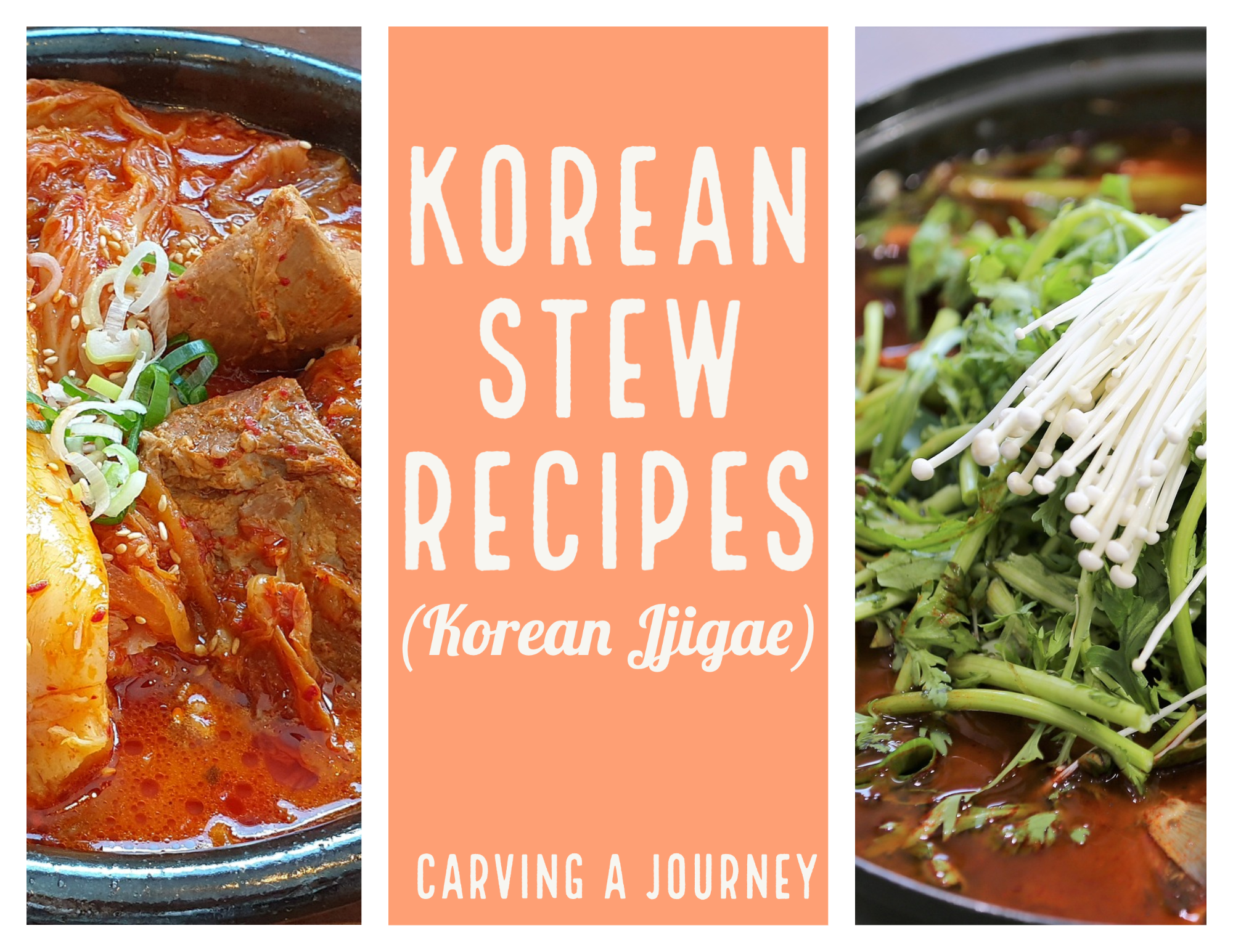This post may contain affiliate links. Please read my disclosure for details at the bottom of this page. As an Amazon Associate, I earn from qualifying purchases on this post listing different Korean stew recipes (Korean jjigae recipes).
Across countries and continents, people around the world somehow managed to develop similar styles of cultural dishes independently of one another. One example of such a dish involves cooking protein and vegetables together in liquid for an extended period. In the end, the cooked meat and vegetables sit in the thickened and reduced sauce. The resulting flavor tastes bold and rich. Based on this description you may think of boeuf bourguignon from France or Brunswick stew in the southern United States–This may also make you think of Korean jjigae! In Korea, jjigae means ‘stew.’ While the cooking methods and premise are similar to those you will find in the west, the flavor is uniquely ‘Korean.’ Below, we listed and introduced 10 Korean stew recipes for you to try making at home!
Korean Stew Recipes (Korean Jjigae)
In South Korea, stew can be served as the main course or on the side of a meal–This entirely depends on the style of the restaurant and what you are eating.
If you go to a stew restaurant, you will eat it as the main course with banchan (side dishes) on the table. Or, you may eat stew as the side as part of a large meal. For example, when eating Korean barbecue, you may notice restaurants often provide a stew such as doenjang jjigae or kimchi jjigae with the meat. Sometimes you need to order the dish. Other times, it is provided for free along with all the other banchan (side dishes).
Below, we listed different Korean stew recipes you can make at home or eat in a restaurant. So, let’s get started!
1. Budae Jjigae (Korean Army Stew)
Budae Jjigae, otherwise known as Korean army stew, is a type of jjigae made from ham, sausage, baked beans, kimchi, gochujang, cheese, noodles, and more. Originally, people invented this dish shortly after the Korean Armistice Agreement that ended the Korean War in 1953. At the time, Koreans made stew using leftovers and smuggled food from the U.S. army bases to feed their families. Since then, budae jjigae has grown into an extremely popular cultural food people often consume when eating soju!
In the end, for this recipe, we recommend checking out Sue’s recipe from her blog My Korean Kitchen!
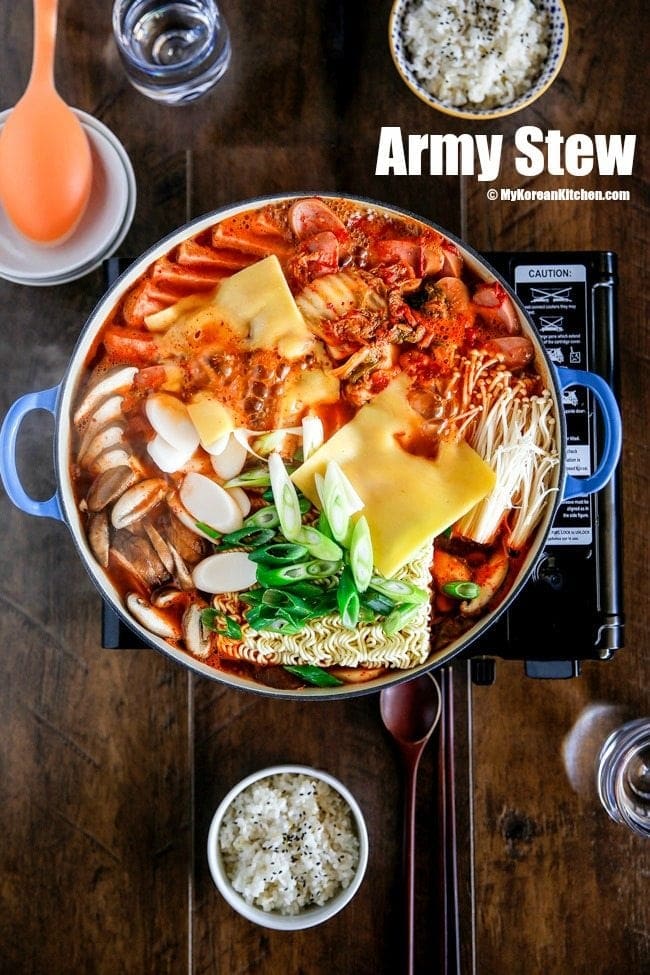
An Overhead Shot of Korean Army Stew With Rice.
2. Doenjang Jjigae (Soybean Paste Stew)
Doenjang jjigae is a traditional Korean stew made using doenjang (soybean paste) as the base ingredient. To make this dish, people dissolve and mix the soybean paste into water or broth. Then, they add additional ingredients such as tofu, seafood, meat, and/or vegetables and boil them in the doenjang liquid base. Often, people eat doenjang jjigae alongside other dishes such as Korean barbecue.
To make doenjang, Koreans ferment soybeans for an extended period until they turn into the paste. The paste tastes earthy, pungent, rich, and salty.
We recommend checking out our recipe for doenjang jjigae. Also, you can check out our blog post listing different types of doenjang jjigae for every type of cook. We have vegan, vegetarian, seafood, and meat versions on that list!
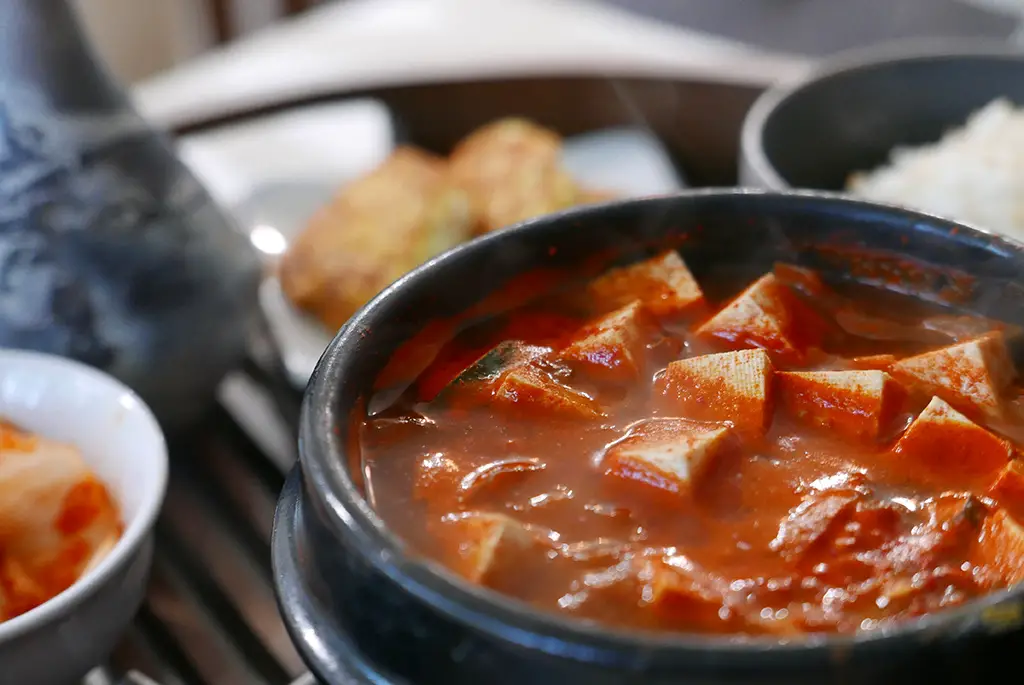
Doenjang Jjigae Filled With Tofu.
3. Kimchi Jjigae (Kimchi Stew)
Kimchi jjigae is a Korean traditional stew made using kimchi and other ingredients such as meat and vegetables. Like doenjang jjigae, kimchi jjigae is a popular stew when eating meals such as Korean barbecue!
Typically, Koreans use older, more fermented kimchi to make kimchi jjigae. As kimchi ages, it becomes more and more sour and pungent. While fresher kimchi is best when eaten on its own, older kimchi works well when fried or added to a stew. For this reason, you use older kimchi for dishes such as kimchi jjigae, kimchi fried rice, or kimchi jeon.
For this recipe, we recommend checking out Hyosun’s recipe from her blog Korean Bapsang!
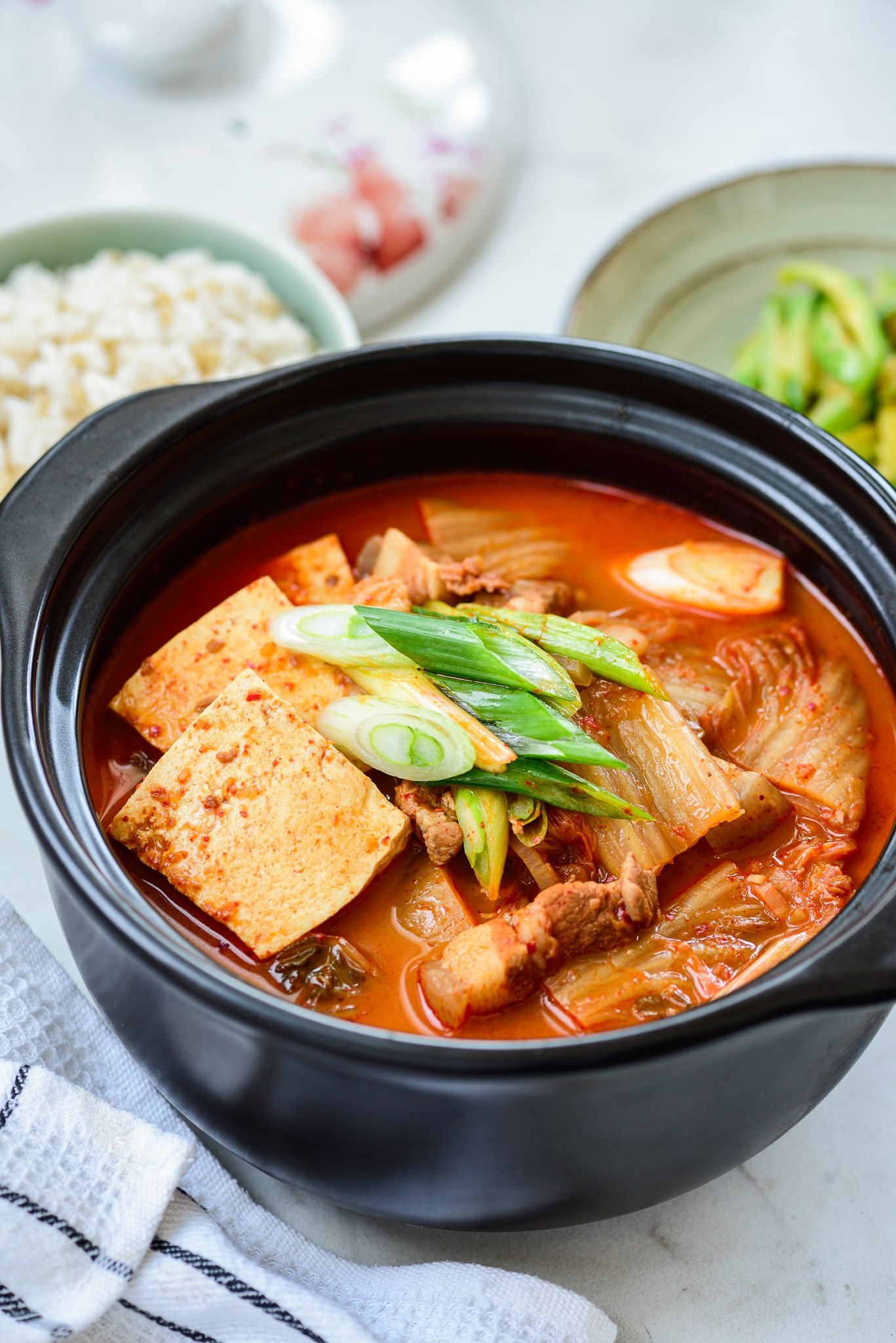
A Large Pot of Kimchi Jjigae!
4. Kkongchi Kimchi Jjigae (Mackerel Pike Kimchi Stew)
In Korea, people love adding seafood to their different stews. If you think about it, South Korea is a peninsula! They have more than enough seafood to go around!
Like the recipe above, this dish is best made with sour kimchi. After all, this is a variation of kimchi jjigae. With this kimchi jjigae recipe, you use mackerel pike as the main protein of the dish. In South Korea, people often make stews with fish that are completely edible when cooked down. In other words, you can eat the entire fish, including the bones. Mackerel pike is one of the types of fish that, when cooked down, you can eat bones and all!
For this recipe, I recommend Holly’s recipe from her blog Beyond Kimchee.

A Large Pot of Korean Mackerel Pike Kimchi Jjigae!
5. Sundubu Jjigae (Soft Tofu Stew)
While dubu jjigae refers to a stew made from firm tofu, sundubu jjigae refers to a stew made from soft tofu. Soft tofu is freshly made tofu that has not been pressed into a firm block. As a result, it has a high water content making the tofu slimy and silky in texture. For that reason, people often refer to soft tofu as silken tofu.
Sundubu jjigae is spicy and packed full of other ingredients such as meat, vegetables, and kimchi. For this recipe, we recommend checking out Maggie’s recipe from her blog Omnivore’s Cookbook.
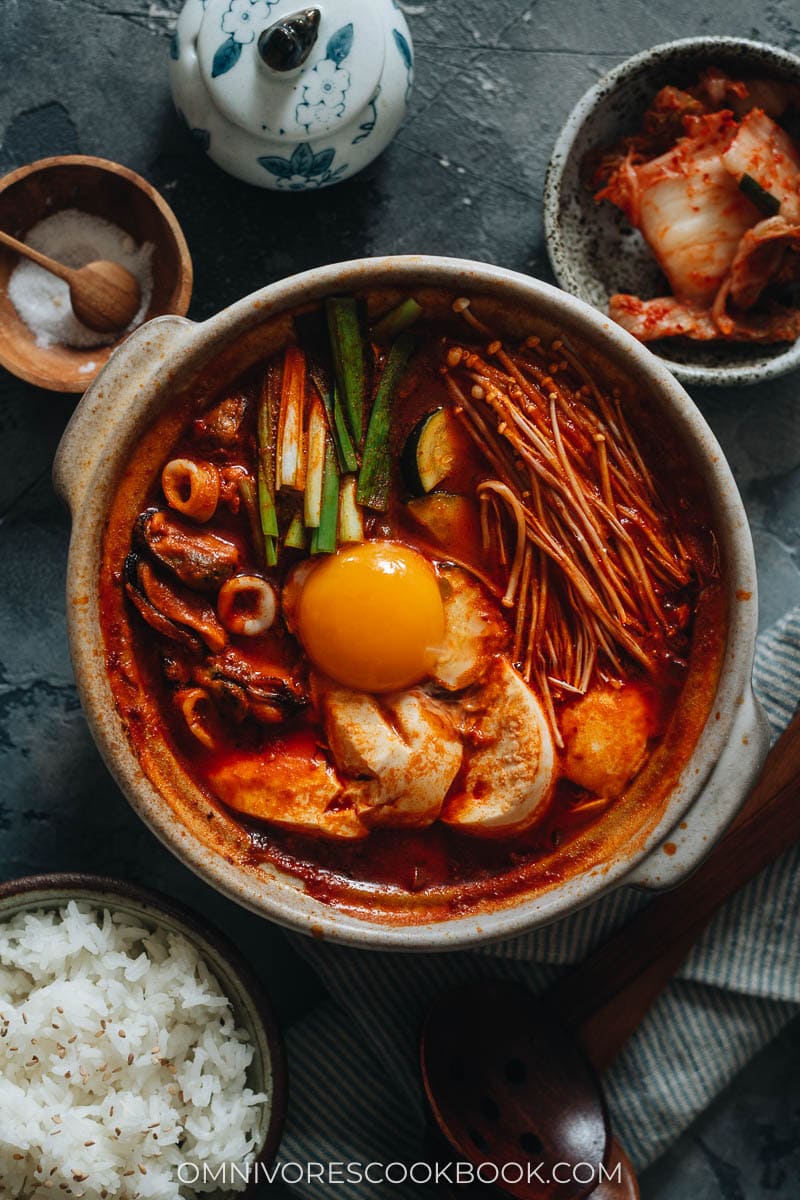
An Overhead Shot of Deliciously Red Sundubu Jjigae!
6. Kongbiji Jjigae (Ground Soybean Stew)
Kongbiji jjigae is a traditional Korean stew made with pureed soybeans. To make this dish, you use kongbiji, otherwise known as the soy pulp that is left over from making tofu. To make tofu, you puree soaked soybeans and then filter them through a fine-meshed sieve. While people use the filtered part to make tofu, they use the left over soy pulp to make dishes such as kongbiji jjigae. In Korea, they use every part of the soybean to make food during the tofu making process!
Typically, you make this stew in a traditional earthenware pot during the cold winter months. This stew tastes a bit nutty from the soybeans. The texture is creamy.
In conclusion, we recommend checking out Maangchi’s video on her Youtube channel for this recipe!
7. Gochujang Jjigae (Red Pepper Paste Stew)
Gochujang jjigae is made using gochujang (red pepper paste) as the base of the soup. For reference, gochujang is a fermented paste made from Korean red peppers. The paste is spicy, slightly sweet, and a tad bit salty. When drinking this soup, the gochujang flavor hits you in the back of the throat warming you from the hot liquid and spice.
Each family will have their version of gochujang soup–While the gochujang base of the soup remains similar, people switch out the different proteins and vegetables added to the dish.
In summary, we recommend checking out Hyosun’s recipe from her blog Korean Bapsang. For her recipe, we like using the clam version!
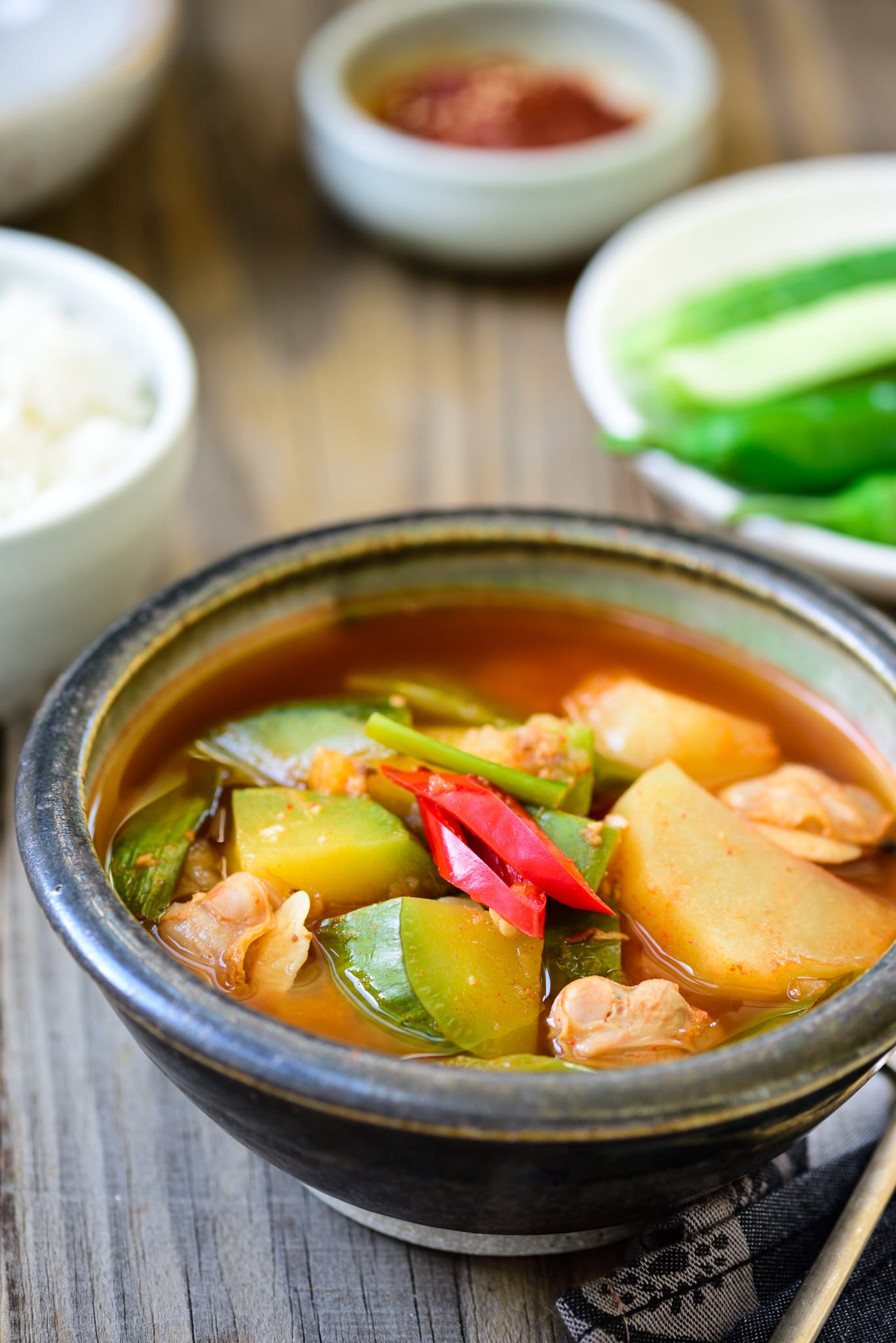
Delicious Gochujang Jjigae Filled With Zucchini
8. Kkotge Jjigae or Kkotgetang (Flower Crab Stew)
Kkotge jjigae refers to a stew with crab as the main ingredients! In South Korea, people refer to these crabs as ‘flower crabs.’ Korean flower crabs have a soft outer shell, so you can easily pull them apart and eat the meat! This is often considered a fall stew as that is when the crabs are in season!
Many people refer to these crabs as ‘blue crabs,’ but they are not the same as the Chesapeake, Maryland crabs. While they have a similar appearance, blue crabs are only considered to be ‘soft shells’ when they have recently molted their outer shell. People harvest these blue crabs before they can fully regrown their shell, so their skin is soft and easy to consume. If you use blue crab to make this dish, make sure to get them during the correct soft shell season.
I recommend checking out the Youtube channel Future Neighbor for this recipe!
9. Altang or Al Jjigae (Spicy Pollock Roe Stew)
Altang Jjigae is a hearty and spicy stew made using pollock roe (fish eggs). This stew is unique because you get flavor bursts of the sea as you eat the roe! Typically, when eating this dish in restaurants, it comes out extremely spicy. So, make sure you have a bowl of rice ready if you cannot handle spice well!
In the end, for this recipe, we recommend checking out JinJoo’s recipe from her blog Kimchimari.
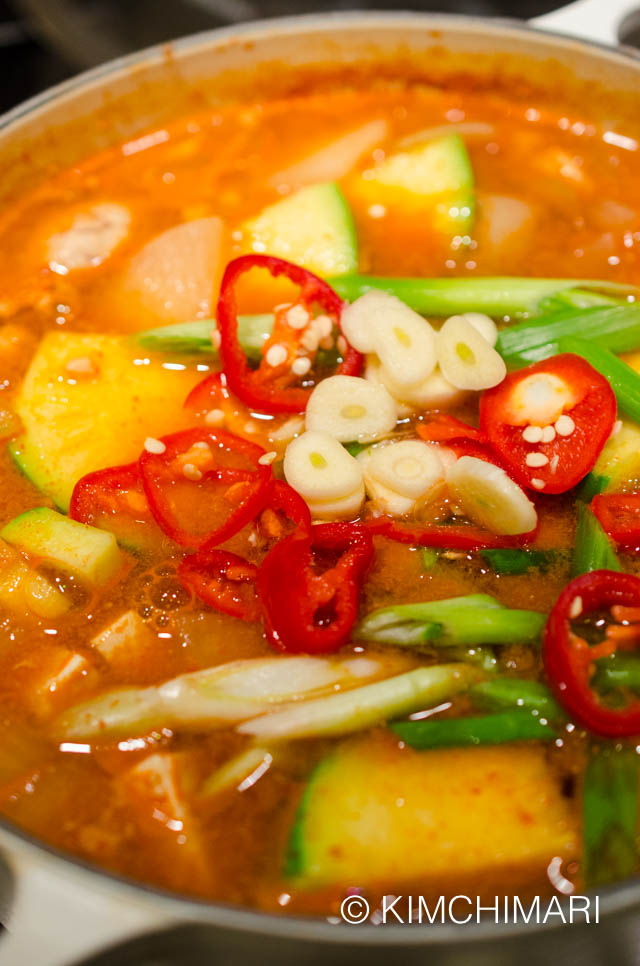
A Closeup Shot of Spicy Al Jjigae
10. Dwaejigogi Hobak Jjigae (Spicy Pork and Zucchini Stew)
A perfect summer recipe is dwaejigogi hobak jjigae! During summer, zucchini is in season. So, why not make a dish filled with zucchini and pork?
In South Korea, people often eat spicy food during the summer months. They believe spicy food cools the body down because it makes you sweat. This stew recipe uses summer vegetables in spicy and hot broth–try this recipe to beat the heat!
Finally, for this recipe, try making Holly’s recipe from Beyond Kimchee. This style of recipe is similar to the gochujang jjigae listed above!

Pork and Zucchini Stew!
Do You Enjoy Korean Stew Recipes?
In the end, did you enjoy eating Korean stew? If so, let us know which is your favorite! Also, we would love to hear of any recommendations in the comment section!
If you would like to read more articles listing different types of Korean food, check out the ones below. Also, we listed some of our other Korean recipes you may enjoy!
Kimbap Recipes and Articles:
- 10 Korean Drink Recipes to Make at Home
- 15 Korean Street Foods I Love
- 10 Best Korean Snacks; and
- 10 Triangle Kimbap and Onigiri Fillings
Korean Food and Drink Recipes:
- Andong Jjimdak
- Mayak Eggs (Korean Marinated Eggs)
- Maneul Jangajji (Korean Pickled Garlic)
- Romaine Sangchu Geotjeori (Korean Romaine Lettuce Salad)
- Soju and Tonic (A Korean Soju Cocktail)
- Soju Caipirinha (A Korean Take on Brazil’s National Drink); and
- Cheese Kimbap
If you have any questions or comments, you can also email us at [email protected].
And, finally, we would love to hear from you through our social media as well! You can follow us at @carvingajourney on Instagram, Twitter, Facebook, and Pinterest. Or, if you would like more articles like these, you can subscribe to our blog by joining our mailing list. We hope you enjoyed our list of Korean stew recipes! Thank you so much for stopping by!
Carving A Journey is a participant in the Amazon Services LLC Associates Program, an affiliate advertising program designed to provide a means for sites to earn advertising fees by advertising and linking to Amazon.com. Although we may earn commissions for our endorsement, recommendation, testimonial, and/or link to any products or services from this website, these opinions are my own and I fully support these products.

